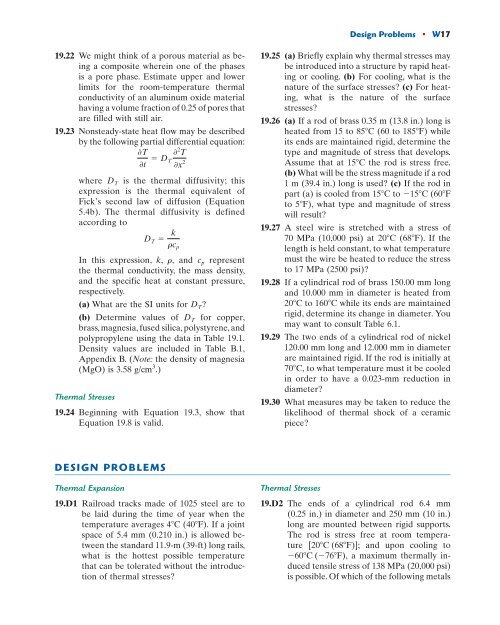Chapter 19 Thermal Properties
Chapter 19 Thermal Properties
Chapter 19 Thermal Properties
- No tags were found...
You also want an ePaper? Increase the reach of your titles
YUMPU automatically turns print PDFs into web optimized ePapers that Google loves.
Design Problems • W17<strong>19</strong>.22 We might think of a porous material as beinga composite wherein one of the phasesis a pore phase. Estimate upper and lowerlimits for the room-temperature thermalconductivity of an aluminum oxide materialhaving a volume fraction of 0.25 of pores thatare filled with still air.<strong>19</strong>.23 Nonsteady-state heat flow may be describedby the following partial differential equation:0T0t D 0 2 TT0x 2D Twhere is the thermal diffusivity; thisexpression is the thermal equivalent ofFick’s second law of diffusion (Equation5.4b). The thermal diffusivity is definedaccording toD T krc pIn this expression, k, r, and c p representthe thermal conductivity, the mass density,and the specific heat at constant pressure,respectively.(a) What are the SI units for D T ?(b) Determine values of D T for copper,brass, magnesia, fused silica, polystyrene, andpolypropylene using the data in Table <strong>19</strong>.1.Density values are included in Table B.1,Appendix B. (Note: the density of magnesia(MgO) is 3.58 g/cm 3 .)<strong>Thermal</strong> Stresses<strong>19</strong>.24 Beginning with Equation <strong>19</strong>.3, show thatEquation <strong>19</strong>.8 is valid.<strong>19</strong>.25 (a) Briefly explain why thermal stresses maybe introduced into a structure by rapid heatingor cooling. (b) For cooling, what is thenature of the surface stresses? (c) For heating,what is the nature of the surfacestresses?<strong>19</strong>.26 (a) If a rod of brass 0.35 m (13.8 in.) long isheated from 15 to 85C (60 to 185F) whileits ends are maintained rigid, determine thetype and magnitude of stress that develops.Assume that at 15C the rod is stress free.(b) What will be the stress magnitude if a rod1 m (39.4 in.) long is used? (c) If the rod inpart (a) is cooled from 15C to 15C (60Fto 5F), what type and magnitude of stresswill result?<strong>19</strong>.27 A steel wire is stretched with a stress of70 MPa (10,000 psi) at 20C ( 68F). If thelength is held constant, to what temperaturemust the wire be heated to reduce the stressto 17 MPa (2500 psi)?<strong>19</strong>.28 If a cylindrical rod of brass 150.00 mm longand 10.000 mm in diameter is heated from20C to 160C while its ends are maintainedrigid, determine its change in diameter. Youmay want to consult Table 6.1.<strong>19</strong>.29 The two ends of a cylindrical rod of nickel120.00 mm long and 12.000 mm in diameterare maintained rigid. If the rod is initially at70C, to what temperature must it be cooledin order to have a 0.023-mm reduction indiameter?<strong>19</strong>.30 What measures may be taken to reduce thelikelihood of thermal shock of a ceramicpiece?DESIGN PROBLEMS<strong>Thermal</strong> Expansion<strong>19</strong>.D1 Railroad tracks made of 1025 steel are tobe laid during the time of year when thetemperature averages 4C (40F). If a jointspace of 5.4 mm (0.210 in.) is allowed betweenthe standard 11.9-m (39-ft) long rails,what is the hottest possible temperaturethat can be tolerated without the introductionof thermal stresses?<strong>Thermal</strong> Stresses<strong>19</strong>.D2 The ends of a cylindrical rod 6.4 mm(0.25 in.) in diameter and 250 mm (10 in.)long are mounted between rigid supports.The rod is stress free at room temperature[20C (68F)]; and upon cooling to60C (76F), a maximum thermally inducedtensile stress of 138 MPa (20,000 psi)is possible. Of which of the following metals












![Data Structures and Algorithms in Java[1].pdf - Fulvio Frisone](https://img.yumpu.com/30982515/1/190x245/data-structures-and-algorithms-in-java1pdf-fulvio-frisone.jpg?quality=85)
![(Microsoft PowerPoint - Topic 4.ppt [Mode de compatibilit\351])](https://img.yumpu.com/30966934/1/190x245/microsoft-powerpoint-topic-4ppt-mode-de-compatibilit351.jpg?quality=85)

